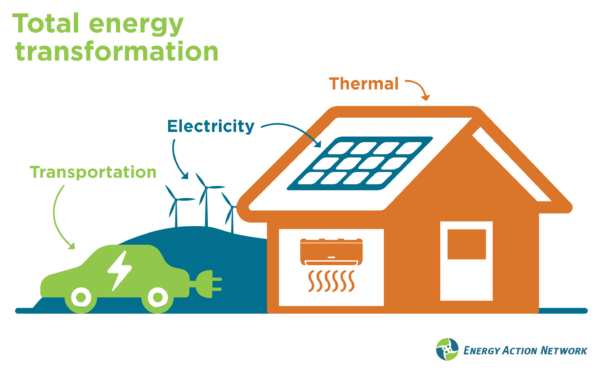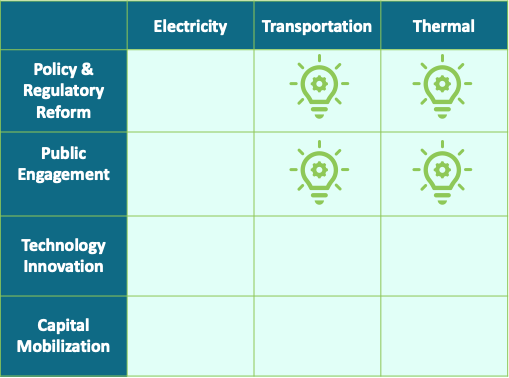Key takeaways from the Vermont Energy Future Initiative and the 2019 Energy Action Network Summit
After a year of work by the Vermont Energy Future Initiative and our recent 2019 Energy Action Summit, our network members have achieved new clarity for the strategic focus of our work together in the coming year.
Findings of the Vermont Energy Future Initiative
The culmination of the Vermont Energy Future Initiative involved identifying priority areas of attention and action for the Energy Action Network – both by energy sector and by strategic areas for intervention – as we plan for the work we will do together in 2020 in service of our mission: to achieve Vermont’s 90% renewable by 2050 total energy commitment and to significantly reduce Vermont’s greenhouse gas emissions in ways that create a more just, thriving, and sustainable future for Vermonters.
Overall, we recognize that while every energy sector is important (and while the boundaries between energy sectors are becoming blurrier in an era of beneficial electrification, which includes electrifying how we get around and heat our homes and businesses), it is clear that the vast amount of Vermont’s fossil fuel use and climate pollution comes from the Transportation and Thermal sectors.
Similarly, while every leverage point for system change that has been identified in EAN’s systems analysis (Policy and Regulatory Reform; Public Engagement; Technology Innovation; and Capital Mobilization) is important, it became clear during the Initiative process that two leverage points– Policy & Regulatory Reform and Public Engagement – are particularly crucial at this moment in time. Additionally, we identified a fifth leverage point – workforce development/workforce transition – to emphasize the need to develop new employees for Vermont’s energy transition, as well as help existing workers transition from the old energy economy to the new energy economy.
More about how Initiative members arrived at these conclusions and a full summary of their work will be on our website in the coming weeks.
Priorities Emerging from the 2019 Summit
The analysis of the Initiative shaped the criteria for pitch selection at our 2019 Energy Action Summit, and, accordingly, seven of the nine pitches we heard at the Summit were focused on policy levers. A written summary and video of each pitch presentation is available on the 2019 Summit page.
While there was interest in every pitch presented at the Summit, based on polling at the Summit and in our subsequent Summit evaluation, network members were most aligned around prioritizing these three pitches::
- The Global Warming Solutions Act
- Harnessing the Power of the EEU Model to Drive Rapid GHG and Cost Reductions
- Zero Energy Now – The Key to Decarbonizing Vermont’s Existing Building Stock
These network member priorities are in step with the findings of the VT Energy Future Initiative that policy and regulatory reform, particularly in the thermal and transportation sectors, will be critical to meeting our energy and emissions reduction commitments.
In the coming year, member organizations will take the lead on these efforts. Where EAN staff can add value by convening or facilitating conversations and connecting partners and resources, on these priorities and the other pitches put forward at the summit, we will do so. And, of course, we will continue doing what you have come to count on us for: objective tracking & analysis via our Annual Progress Report, with new research, and via our Fellows program. We will also continue to provide ongoing opportunities for shared learning, whether through our monthly newsletter, the Leveraging Change Speaker Series, or other Network convenings.
Updates and Next Steps
We are already working with each of the pilot programs that were pitched at the Summit: Zero Energy Now, and the Next Generation Mobility and Access proposal from Capstone Community Action, to provide support as needed. We will also be focusing our next Leveraging Change Speaker Series event on November 14th around the Global Warming Solutions Act and lessons learned from implementation in Massachusetts and elsewhere.
The findings of the Initiative and the priorities emerging from the Summit will also inform the framing of our 2019 Annual Progress Report, which we are beginning to work on in earnest this month.
We look forward to hearing from Network Members and Public Partners on how we can continue to support you and create more opportunities for collaboration in our shared efforts to achieve our Network’s mission and Vermont’s energy & emissions reduction commitments.
If you have any questions or would like to provide feedback, please contact Jared Duval, EAN Executive Director and Carolyn Wesley, EAN Network Manager.

